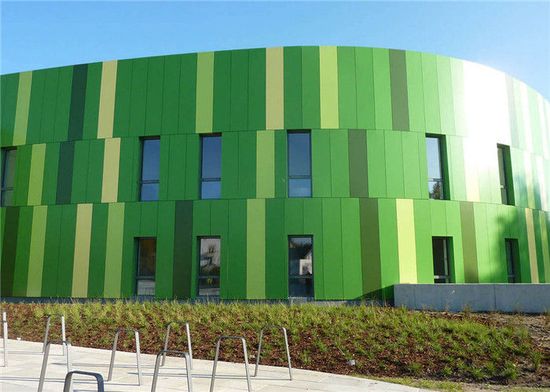Elevating sustainability: The advantage of aluminium composite facades for modern buildings
Team AL Circle
2023-11-18
Building facades are becoming more than just a protective cover for the buildings. They are also the artistic and functional aspects of contemporary structures. Architects are integrating innovation and modern designs to birth spectacular statements. But what about sustainability? A study in 2021 reveals that the facade can contribute up to 30% of the building's embodied carbon footprint.
As developers move towards green building, they strive to incorporate environment-friendly materials in the construction process. Aluminium composite facades are an eco-friendly option that allows designers to make dynamic yet sustainable designs.

Aluminium composite panels, or ACPs, are a top choice for building facades because they are flexible, lightweight, versatile, and durable. Moreover, they largely contribute to the idea of green buildings.
Why do modern buildings use aluminium composite facades?
One of the primary reasons architects prefer using aluminium is because it is easy to use, and they can create unique designs with the malleable metal. In addition, aluminium composite panels are available in different colours, sizes and styles. However, there is more to it than the aesthetic value. Aluminium composite panels can help a building become energy-efficient and eco-friendly in various ways. Here are a few advantages of using ACP facades:
- Temperature regulation: Aluminium composite facades help in reducing the temperature inside the building by 10 degrees Celsius. It adds a layer of heat protection to the building and prevents heat from entering. Therefore, those in the building do not experience extreme temperatures.
- Energy-saving aid: Since the internal temperature remains less, it directly facilitates energy conservation. Due to its excellent insulating properties, aluminium composite panels are used to make facades, as ACP-clad buildings do not require excessive cooling or heating. Therefore, consume less energy and save on operational cost.
- Highly durable: Aluminium is a corrosion-resistant metal since it creates a coating of aluminium oxide when it comes in contact with oxygen. Furthermore, aluminium composite panels are pre-treated to increase their durability so they stay sturdy and do not corrode after extensive use. Since the ACP facades do not damage easily, they do not require frequent replacement and lessen the production impact on the environment.
- Reduced carbon footprint: Producing aluminium composite panels requires less energy. It also reduces emissions. Hence, it reduces the carbon footprint of the building from the very beginning of the project. These properties of ACPs attract conscious consumers.
- Recyclability: Since aluminium is a recyclable metal, its recyclable properties remain unchanged in aluminium composite panels. Therefore, they can be used for a long time and reduce environmental impact. Aluminium can be recycled up to 90%, making it the safest material for building facades.
- Integration with other sustainability concepts: Aluminum composite facades can be integrated with other eco-friendly building systems, such as green roofs, rainwater harvesting, and solar panels. All these together help the building become sustainable and environmentally friendly.
- Fire resistance: Some ACPs are made fire-resistant. You can ask the architect or supplier to provide such aluminium composite facades to create a safer structure for the inhabitants as well as the environment. These facades protect lives and property and do not contribute to air pollution.
Despite its numerous advantages, aluminium composite facades have some drawbacks. ACP facades can be more expensive than cladding materials like dry walls or plaster. Next, although installing these facades is relatively simple, it requires some special tools and skills to work with them. If installed poorly, the facades may dent during strong winds and storms. You cannot achieve a woodsy or natural look for the exterior with ACP facades. However, it is important to note that ACP facades' mechanical, operational, and ecological benefits outweigh its disadvantages.
The future of modern building
Modern green buildings blend architectural prowess and conscious consumerism and design. As building facades become a staple, aluminium composite panels will play a vital role in achieving sustainability and energy efficiency. It is important to note that the rise in sustainability culture in the construction sector also facilitates the growth of the aluminium industry. Now, both share a symbiotic relationship. Aluminium composite facades will help a building match all the sustainability concepts like energy efficiency, carbon footprint reduction, lesser emissions, etc.
To understand the construction industry's integration of aluminium and its drive toward sustainability, delve into the e-Magazine publication by AL Circle titled "Aluminium - Revolutionizing the Construction Sector." This edition provides valuable insights into how the building and construction sector has strategically embraced aluminium, showcasing its transformative impact on the industry's practices and its pivotal role in fostering a sustainable future.
Categories
Raw Materials
Scrap
Consumables
Primary Aluminium
Secondary Aluminium
Equipment
Technology
Downstream Products
Finished Products
Utilities
Services
Others
Recent Blogs
Subscribe to newsletter
Connect with us











